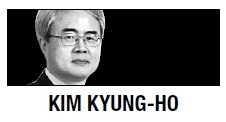Opposition lawmaker Ahn Cheol-soo traveled to Sejong City, an administrative town about 150 kilometers south of Seoul, to attend a press conference on Saturday arranged to brief reporters on the results of the World Health Organization’s on-site study into the spread of Middle East respiratory syndrome across the country.

He was barred from entering the conference hall under WHO guidelines allowing only journalists to participate in a news briefing by its officials. Ahn, a medical doctor-turned-politician who sits on the parliamentary health and welfare committee, might have hoped to score political points by holding discussions with WHO experts in the nationally televised event. In reality, he had to stand at the entrance, taking notes of the briefing.
Ahn’s critics described this scene as a self-invited embarrassment. But the lawmaker might be credited at least for having traveled from Seoul to the administrative town, where the Ministry of Health and Welfare is located along with a dozen other central government agencies.
A special parliamentary committee formed to deal with the spread of the MERS virus summoned more than 30 health officials and medical experts to its first session last week to lash out at them and ask mostly pointless questions. The committee should not have disrupted their urgent task of fighting the disease to do this. To attend the session, which served largely as a stage for insignificant political shows, some of them had to travel to Seoul from Sejong City and a nearby city where the Korea Centers for Disease Control and Prevention is located.
It has become routine for ministers and other senior officials to shuttle between Seoul and Sejong City since central government ministries began moving to the administrative town in 2012. They have spent more time attending parliamentary sessions and Cabinet meetings presided over by President Park Geun-hye in Seoul than handling work at their offices in Sejong City.
As many critics note, the government’s botched response to the MERS outbreak might be partly attributable to the administrative inefficiency stemming from the dividing of state functions between Seoul and Sejong City.
Health authorities have been criticized for their failure to impose strong quarantine measures and make public detailed information on the outbreak of the deadly infectious disease at its initial stages. Their clumsy and negligent response has resulted in the spread of the MERS virus across the country, sparking public scares that are transforming into social and economic disruption.
This deplorable inability contrasts with the government’s efficiency in preventing the outbreak of the severe acute respiratory syndrome in Korea in 2003. At the time, an inter-ministerial response team was set up quickly under the prime minister.
Some officials at the Health Ministry conceded their work attitude had become relaxed, with its minister out of his office on most weekdays. The minister, Moon Hyung-pyo, might not have had due interest in working on measures to cope with the MERS outbreak while paying more attention to a move by political parties to change the public pension scheme in Seoul. This atmosphere might have been behind the ministry’s failure to appreciate the potential danger of the disease that was first reported on May 20.
Early this month, the public was perplexed by different views expressed by the education minister in Seoul and a senior health official in Sejong City on the need to close schools.
It may not be an exaggerated concern that the administrative inefficiency will continue to undermine the government’s capabilities to react to emergencies in a quick and organized manner.
President Park is not free of responsibilities for the perceived administrative dysfunction. As a ruling party lawmaker, she played a key role in blocking then-President Lee Myung-bak’s attempt to replace the planned administrative town with a business and research hub in 2010.
It was the late President Roh Moo-hyun who initiated the idea of moving the capital from Seoul to a place in the central part of the country with the pretext of promoting balanced regional development. After the Constitutional Court ruled a related law unconstitutional in 2003, Roh and other political leaders circumvented the ruling by pushing for a plan to build an administrative town to accommodate most of the government agencies except for the presidential office and ministries in charge of security and diplomatic affairs.
The painful failure to contain the spread of the MERS virus should also serve to give serious consideration to how to reduce what critics describe as the risk of Sejong City.
Moving the National Assembly to the administrative town might be an effective way to settle the problem. But it would take time as changes to the law that stipulates the presidential office, parliament and the judiciary cannot sit in Sejong City would need to be made. The move might also contradict the 2003 ruling by the Constitutional Court. Still, a great deal of discussion on it is needed over the long term.
Lawmakers have to become more positive about the idea, which few people would oppose. More immediately, they should refrain from summoning ministers and other senior administration officials to parliamentary sessions when their attendance is unnecessary.
President Park may be held more responsible for resolving the inefficiency stemming from the creation of the administrative town she advocated. She needs to give full authority to Cabinet members, letting them concentrate on their work in Sejong City.
Park made a rare visit to the administrative town Wednesday to encourage the task force set up at the Health Ministry to coordinate efforts to contain the spread of the deadly virus. On the way back to her office, she might have thought it would be more efficient for the task force to be headquartered in Seoul.
By Kim Kyung-ho
Kim Kyung-ho is an editorial writer for The Korea Herald. He can be contacted at khkim@heraldcorp.com. ― Ed.



